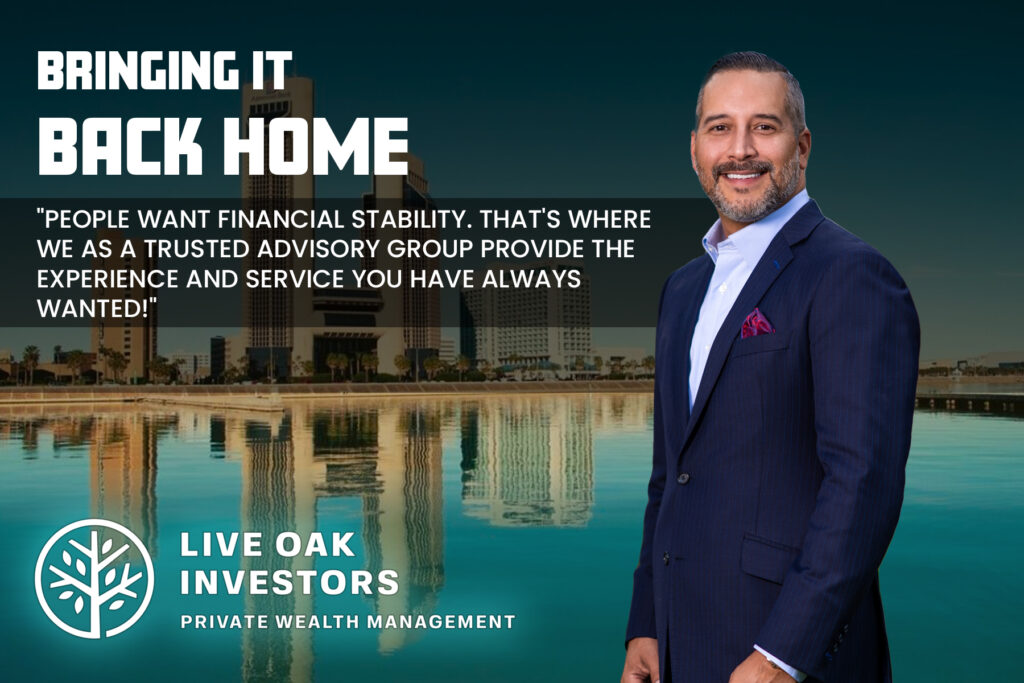Behavioral Coaching

With his passion for financial planning and focus on providing stellar client service, Jason Zamora brings Live Oak Investors home to the Sparkling City by the Sea.
By: Kara George
Jason Zamora’s vision for Live Oak Investors was to create a private wealth management group providing customized and personalized financial services. A group based on the principles of trust and commitment to a successful financial future. A place where clients would feel at home with an advisor they could trust. Zamora has successfully created this atmosphere 25 years later by applying principles from his own childhood and hometown experiences.
After graduating from Incarnate Word Academy in 1994, Zamora left his hometown of Corpus Christi to pursue an education in finance. Attending St. Mary’s University, he majored in corporate finance with a minor in accounting. Directly upon graduation, he went to work for New York Life Insurance companies at the age of 22. After three years, Zamora became the youngest advisor to be promoted to partner with New York Life. Now responsible for recruiting and developing, Zamora began to miss the one-on-one interaction he previously had with his clients.
“If I was going to make it or break it in this business, I wanted to do it myself,” Zamora said. At the age of 28, he established Live Oak Investors and reconnected with his passion for financial planning.
His excitement for helping others with their financial futures stemmed from his youth experiences. “My mom was a single parent, and I knew there was a lot of luck involved with me having the lifestyle I did as a kid, Zamora said. “I wanted to take the luck out of someone being financially fit. When helping families with children, I don’t want them to be able to go to college by accident. I want it to be more calculated and planned out.”

Today, Zamora applies these beliefs to his business and expresses the importance of a plan to his clients, encouraging them to not base their financial future on luck alone.
Casper Wenzel, a retired IWA basketball coach, also played a key role in shaping Zamora’s business beliefs. Wenzel’s words of wisdom, “You don’t stay the same; you either get better or worse” still resonate with Zamora as he strives for growth, both personally and professionally, each day.
“You realize later on they are teaching you more about life rather than sports,” Zamora said of Wenzel. Taking these key principles he learned from his hometown heroes, Zamora has been able to help others and expand Live Oak Investors.
Recently, Zamora has been able to connect his present and his past with his true passion by expanding Live Oak Investors back to his hometown. About 90 percent of Zamora’s business is now based in the Hill Country and South Texas area.
“It’s ironic to have left Corpus, and now have found my way back,” Zamora said. Returning to his hometown, Zamora has built a strong connection with the retirement community, “The fact that I can help retirees with their retirement planning needs so close to home has been what I thrive on,” he said.
Zamora’s team at Live Oak Investors helps clients feel at home by building a trusting rapport and putting clients’ goals first. “Being the largest isn’t the most important thing to me; it’s about being recognized for exceptional client service,” Zamora said. “It’s not about getting attention; it’s about attention to detail.”
He believes as a fiduciary he should be readily accessible to clients when needed, whether it is for business or personal tasks. Zamora understands that many investors have anxiety when it comes to financial planning and retirement, which is why he believes delivering a customized plan and performance is key.
“When I look around and see my wife and children, it motivates me to do my best and perform in a way that will enable other families to solidify their future for those that they love so much!”
For more information on Live Oak Investors, visit www.liveoakinvestors.com or contact the team directly at 830-331-1113.

[Boerne, Texas July 21, 2023] – Revolution Wealth Management has joined Live Oak Investors – two respected financial advice firms serving the greater Texas market, are announcing the forming of a powerhouse partnership that will deliver exceptional wealth management and advisory services to clients across the state. The combined firms will operate under the name Live Oak Investors – Private Wealth Management.
With a shared commitment to providing comprehensive financial solutions and exceptional client experiences, Live Oak Investors and Revolution Wealth Management bring together their expertise, resources, and talented teams to create a leading force in the financial advisory industry. The merger is set to strengthen their market presence and enhance the range of services offered to their valued clients.
With over 150 years of experience combined, and a dedicated vision of managing generational wealth, Live Oak has further solidified their position as a trusted partner in the wealth management industry. Additionally, Live Oak Investors will proudly serve 1,300 households, providing tailored financial strategies to meet their unique needs and goals.
“We are excited to join forces with Revolution Wealth Management and embark on this new chapter together,” said Jason Zamora, Founder and President of Live Oak Investors. “By merging our firms, we can leverage our shared expertise and resources to offer an even higher level of service and value to our clients. Together, we will be better positioned to navigate the ever-changing financial landscape and provide innovative solutions to help our clients achieve their financial objectives and retire with confidence.”

The merger brings together a talented team of financial advisors, portfolio managers, and client service professionals who are dedicated to upholding the highest standards of excellence and integrity. With a client-centric approach, Live Oak Investors will continue to deliver personalized financial advice, retirement planning, investment management, and estate planning services, among others, to individuals, families, and businesses throughout Texas.
“We believe that this merger will be highly beneficial to our clients,” said Holly Hagle, of Revolution Wealth Management. “By combining our expertise and resources, we will have the capacity to offer an expanded range of services, advanced technology platforms, and a deeper bench of experienced professionals. This positions us to better serve our clients’ evolving needs and helps them pursue their financial goals with confidence.”
For additional information or inquiries, please visit:
Or call:
Phone: 830-331-1113
Email: j.zamora@lpl.com
About Live Oak Investors:
Live Oak Investors – Private Wealth Mgmt is a leading financial advice firm serving the Texas Hill Country and the greater South Texas market. With a client-centric approach, Live Oak Investors offers comprehensive wealth management services, including financial planning, investment management, retirement planning, estate planning, and more. By delivering personalized strategies and exceptional service, Live Oak Investors helps clients pursue their financial goals and build a secure future.
About Revolution Wealth Management:
Revolution Wealth Management is a prominent financial advisory firm with a strong presence in Texas. Committed to delivering exceptional client experiences, Revolution Wealth Management provides comprehensive wealth management services, retirement planning, investment management, and tailored financial strategies to individuals, families, and businesses.
Securities and advisory services are offered through LPL Financial (LPL), a registered investment advisor and broker-dealer (member FINRA/SIPC).

Retirement is a major goal many workers keep their eye on throughout their career.
However, once people actually reach retirement age, they are often in store for some financial surprises — despite decades of preparation.

Saving for retirement is one of those pursuits that can be hard to wrap your head around. After all, how many other life milestones require decades and decades to come to fruition? Since so much time and preparation goes into it, though, it’s extra important to take care that you’re avoiding the top retirement planning mistakes that financial planners see all the time.

When others were looking for the exits during Tuesday’s selloff, many retail investors saw an entrance to more future gains — but what were they stepping into?

Like many current and future retirees, we are eyeing our investment accounts daily, worrying how seriously the current market losses and global economic upheavals might erode the savings we’ve projected to see us through our remaining years.
We weathered the volatility of the 2007-09 recession, so we have had experience with a devastating market downturn turning into a robust market rebound. But that was a dozen years ago, when we felt we had enough time and employment income to help us recover any losses. Now, with our income reduced to payments from Social Security, a few pensions and returns on investments, we haven’t been feeling as confident.
When I called our adviser, I needed reassurance.

With the first half of the year behind us, now is a good time for a quick, midyear financial check-in. Knowing that you have places to be and people to see this summer, let’s get right to assessing if you’re on course to realize your financial goals or need to pivot in order to do so.
Read More

Will the bear market inflict a bigger bite on retirees than younger investors? Not necessarily, experts say, as the duration of the average bear market is measured in months and retirees who are able to stay the course should be able to recover losses.

With everything going on in the world, it can feel selfish — even petty — to be worrying about your 401(k) and IRA accounts right now.

There’s an important reminder for investors to keep in mind when the markets are volatile

Talk of a recession is heating up, with Wall Street veterans flagging the rising risks of a downturn — and offering advice on how to invest during this cycle.

Market ups and downs can keep retirees on edge, worried about potentially big losses from which they may never be able to recover.
And those worries aren’t necessarily misguided. From 1928 through March 2022, there have been 26 “bear markets.” A bear market is a market decline greater than 20% that lasts at least two months. The average bear market decline since 1928 has been 35.62%, so the potential for big losses is real.

After rebounding from the short-lived pandemic recession, the U.S. economy has faced multiple threats in 2022, sparking investor fears of a prolonged downturn.

Social Security is a critical source of income for many retirees, but the size of your monthly payment changes based on when you start receiving your benefits.

The global pandemic, war in Ukraine and other world events have contributed to wild swings in the stock market. Retirement savers have seen both tremendous gains and precipitous losses in their 401(k) investments over just the past two years.
A steep drop in the stock market can be particularly devastating to retirees, who have few options to replace their depleted life savings. But there are a variety of ways for retirees to prepare for and cope with stock market declines so that their day-to-day income needs continue to be met, regardless of market conditions. Here’s how to protect yourself from stock market risk in retirement:

During your working years, your largest income stream is generally from employment. When you retire, however, your income will likely need to come from a variety of sources, such as retirement accounts, after-tax investments, Social Security, pensions or even continued part-time work.
For those looking to create a retirement income stream, there are a variety of strategies available depending upon your specific income needs and lifetime goals. Two simple retirement income strategies include the total return approach and the bucket approach.
Total Return Approach to Retirement Income
The total return approach is probably the best-known strategy. With this approach, assets are invested with a focus on diversification, using a portfolio of investments with a varied potential for growth, stability and liquidity, based on your time horizon, risk tolerance and need for current and future income. There are three defined stages within this approach, which are contingent upon how near you are to retirement:
Accumulation phase: During peak earnings years, the objective is to increase total portfolio value through long-term investments that offer growth potential.
Pre-retirement phase: As you approach retirement this should include a gradual move toward a more balanced growth and income-based portfolio, with an increased allocation toward stable and liquid assets as a means of preserving your earnings.
Retirement phase: Once retired, maximizing tax-efficient income while protecting against principal decline may result in a portfolio heavily weighted toward income-producing liquid assets.
Pros and cons: The benefit of adopting the total return approach is that, as a rule, the portfolio should outperform one that is heavily weighted toward income generation over a longer time frame. The largest disadvantage of this approach is that it takes discipline. It is important to remember that the appropriate withdrawal rate should depend upon your personal situation and the economic environment, though many advisers suggest starting with a withdrawal rate of 3%-5%, which may then be adjusted each year for inflation.
Bucket Approach to Retirement Income
This approach behaves similarly to the total return approach throughout the accumulation phase, but as you enter pre-retirement, you divide your assets into smaller portfolio “buckets” with each holding investments geared toward different time horizons and targeted to meet different needs. Generally there are three common bucket types based upon specific needs, but you are certainly not limited to just these three:
Safety bucket: This bucket is set up to cover a period of about three years and focuses on relatively stable investments, such as short- to intermediate-term bonds, CDs, money market funds, bond ladders and cash. This portfolio is designed to cover your needs and avoid tapping into the next two buckets when markets are down, since the average bear market historically lasts less than three years.
Income bucket: This bucket should focus on seven years of income needs and is designed to generate retirement income while preserving some capital over a full market cycle. This bucket typically includes assets with a focus on distributing income while still providing some growth potential. Examples might include high-quality dividend-paying stocks, real estate investment trusts or high-yield corporate bonds.
Growth bucket: This bucket is used to replace the first two buckets after 10 years and beyond and contains investments that have the most potential for growth, such as non-dividend paying equities, commodities and alternatives assets. Though holding a higher risk profile, this portfolio has a longer time horizon thus more time to make up short-term losses.
Pros and cons: The benefit of adopting the bucket approach is that it can help create a sense of calm during market storms. Instead of panicking oneself out of growth assets during a downturn, a retiree can feel confident knowing their next several years of income needs are already in a more conservative position. The difficulty with this approach is deciding when to move assets from one bucket to the next, again requiring discipline.
Funding Sources for Creating a Retirement Income Stream
Beyond Social Security and pensions, a number of instruments can be used to create retirement income. Which ones you use will depend upon your specific goals.
Interest and dividends: The benefit of this source is that investors can expect to receive a stated consistent monthly or quarterly payment using an instrument like dividend-paying stocks, closed end funds (CEFs) or exchange-traded funds (ETFs) with a long-term track record. The disadvantage of relying on interest and dividends is that most retirees cannot live on these payments alone, especially when yields are low and inflation is high. Additionally, when it comes to dividend payouts, companies can adjust them, cut them, or even stop them altogether.
Bond ladder: This strategy involves building a portfolio of multiple individual bonds that mature at varied stepped dates, often annually. When each bond matures, the ladder is extended by purchasing another bond, or it may fund the income need in that given year. The benefit is that a bond ladder can offer consistent, predictable return on investment. Additionally, it provides protection from some call risk, as it is unlikely the bonds would be called at the same time. The disadvantage of this income source is you may be forced to reinvest at lower interest rates, quality of bonds can vary in risk, and they can have a return lower than inflation, especially if purchased at a premium to the par value.
Certificate of deposit (CD) ladder: Similar to a bond ladder, this type of investment involves purchasing multiple certificates of deposit with stepped maturity dates. A new CD is purchased as each one matures later than the next, extending the ladder, or again used as income at maturity. While this income source is more secure than the bond ladder because CDs are insured by the FDIC, interest is not paid upon maturity. Also, be aware that some CDs automatically reinvest, which could keep you from receiving the income, so it is wise to look specifically for CDs without this feature.
Annuities: With immediate annuities that are backed by an insurance company, you pay a lump sum in exchange for a guaranteed payment that starts immediately. With deferred annuities, you invest in a contract, but the payout may not start for several years. While they are reasonably secure and offer tax-deferred growth and potentially tax-advantaged income, there are several disadvantages. The fees can be high, there is a tax penalty for withdrawals prior to age 59½, and they may be difficult to get out of without surrender charges if you later change your mind. It’s important to look for highly rated insurance companies when searching for guarantees because they can be dependent on the claims-paying ability of the insurance company.
Managed payout: A managed payout fund is also known as a Retirement Income Fund (RIF), income replacement fund, or monthly income fund. This source often consists of mutual funds generally created with retirees in mind, which pay regular and predictable income. The caveat being that income is not guaranteed and payments often fluctuate, and the fund manager may use principal to meet the payout schedule.
Real estate investment trusts (REIT): A REIT is a company that owns or invests in income-producing real estate and allows individuals to invest in large-scale commercial real estate or real estate loans. Types of REITs include:
Publicly traded: Available on the major stock exchanges.
Public, non-traded: Open to all investors, but may lack liquidity and do not trade on the primary stock exchanges.
Private, non-trade: Usually not open to the public due to high net-worth and/or high-income requirements. Again, may lack liquidity and do not trade on the primary stock exchanges
REITs are further broken down by type, including:
Equity REIT: Owns income-producing real estate like office, industrial, retail, hospitality, residential, timber, healthcare, self-storage, data centers, and infrastructure.
Mortgage REIT (mREIT): Provides financing for real estate.
Hybrid REIT: Combines income-producing real estate investments and real-estate backed loans.
The benefit of REITs is that they may offer a reasonable hedge against inflation as most of their taxable income must be distributed to shareholders.
Part-time income: Not everyone is fully ready for retirement, and work can offer a sense of self-worth. The additional income can help hedge against inflation by covering expenses during a down market instead of selling investments at a loss to pay the bills. The chief caveat is the potential reduction of Social Security benefits while earning income due to the Social Security Administration earnings test.
Alternative investments: These investments do not fit into the traditional equity, fixed income or cash options. For this purpose, they generally consist of private equity, venture capital, hedge funds, commodities, tangible assets and real property.
As you can see, there is no one-size-fits-all approach to retirement income planning. Each of these strategies requires a dramatically different approach. With this in mind, you should seek the advice of your financial adviser to help you construct a customized portfolio that will meet your retirement needs.
by Kris Maksimovich, AIF®, CRPC®, CRC®
 You can’t read much in the financial press these days without being confronted by the challenges of inflation. It’s hit the economy with a vengeance. We all know that inflation erodes our purchasing power and thus there is a big temptation to do something to inflation-proof our portfolios. Read More
You can’t read much in the financial press these days without being confronted by the challenges of inflation. It’s hit the economy with a vengeance. We all know that inflation erodes our purchasing power and thus there is a big temptation to do something to inflation-proof our portfolios. Read More
First, don’t panic. But do tune in to how you’re feeling right now.

Every worker should be prioritizing retirement savings to ensure they have a secure future. Investing for your later years is important because you can’t live on Social Security alone.

Maybe you feel like you don’t earn enough. Or you don’t understand how investing works. Or maybe you can’t organize your finances. These are factors that can lead to financial stress and set back your retirement savings. Read More

Financial uncertainty is one of the biggest sources of stress among Americans in or approaching retirement. Read More

A study conducted by the American Psychological Association in 2021 shows 61% of Americans cite “money” as a “very/somewhat significant” cause of stress. Read More
When it comes to retirement, saving money is generally not enough; you will likely need to invest it to ensure you have enough to live comfortably in your later years. 

The main goal of most investors is to garner enough money in the market to fund their retirement years. Yet, many investors are unsure of how to properly pull money out of their accounts once they’re actually in retirement. Read More
Since you’re reading this, my guess is that you’re at least a bit concerned about your financial future. That’s good. If you’re a reasonable adult, you’ve likely grasped that planning for that is a must, particularly in this era of uncertainty. After all, money worries and the stress they produce is one of the biggest enemies of peaceful living.
Before predicting what the new year holds for the financial advice industry, we must first look back on a 2021 filled with Covid-19-related instability: surging inflation rates, persistant unemployment and the most volatile period for stocks in nearly a decade. Read More
Retiring on time isn’t something everyone gets the luxury to do. If you’re behind on savings, you may feel compelled to delay your retirement and work on boosting your nest egg, even if that means having to plug away at a desk job for a few more years. Read More
Throughout the U.S., many people have far too little retirement savings to support themselves after they stop getting paychecks.
There are some common reasons why so many workers are unable to save for their later years. In fact, more than 9 in 10 people responding to a recent Goldman Sachs survey identified the same key issue that’s interfering with their efforts to invest for their future.
Read More

Most Americans feel like they’re saving up plenty to retire comfortably, but for many people, it’s probably not enough, according to recent data. Read More
Key Points
- Preparing for retirement security requires a lifelong commitment.
- You’ll want to make the right choices this year regarding Social Security.
- Investing as much as possible this year can help set you up for retirement.

Read More

When it comes to saving for retirement, the earlier you can start, the better. Read More
With prices rising at their fastest rate in decades, people in retirement or approaching it should take extra care to protect their savings.
 Shuran Huang for The New York Times
Shuran Huang for The New York Times
Read More
How to assess where you are and what you can still do to get ready for retirement.

If you find that your current accounts won’t provide the desired income you would like in retirement, you can make some additional changes.
There is still time to improve your retirement finances in the years leading up to retirement. By reviewing how much you have saved and thinking about how much longer you want to work, you may be able to update and improve your retirement plan. Use the following guidelines to get ready for retirement after age 60. Read More

A common financial rule of thumb is that you should have $1 million saved for retirement, but this piece of advice may now be outdated — you may actually need roughly double that. Read More

After decades of hard work, retirement is the time to relax and enjoy your golden years. But it takes careful planning to ensure that you can live out these years feeling secure financially.
Here’s how to Live Richer in retirement. Read More
A financial checkup could help put your mind at ease

Fewer than 1 in 5 people have established a comprehensive financial plan for their retirement, according to a Fidelity Investments study. But even if you are among those who do, how do you know your plan will hold up in every insomnia-inducing scenario you envision? Read More
Financial planners see people making these six money mistakes all the time, and they can endanger your retirement. Here are six surefire ways to kill your retirement – and how to get back on track from them.

If you’re starting to wonder if you’ll ever have enough money saved to retire, you aren’t alone. Read More
Timing is everything when it comes to retiring comfortably

After years of hard work, you’re certainly entitled to a happy retirement. You may have already started daydreaming about it, at least a little. Will you travel the world, volunteer for your favorite charity, go fishing, or spend more time with the grandkids? The possibilities are endless. Read More

Turning wealth into income isn’t the easiest of tasks. And more than a few people make mistakes with their money before and during retirement.
Some mistakes are, unfortunately, irrevocable. But some, thankfully, are not. Read More
 FluxFactory / Getty Images
FluxFactory / Getty Images
In your 20s, as you start your career and make real money for the first time, your spending changes. After living with Mom and Dad or in a college dorm, you can afford a place of your own and might want to splurge on the place with the amazing rooftop deck. You might have some disposable income for the first time — even after making the monthly payment on those student loans — and want to take a weekend trip each month with friends. Read More

People in their 50s who are nearing retirement have a lot on their plates. Between mortgages, adult-age kids and other responsibilities, it can be hard to prioritize everything. However, it’s never too late to prepare yourself for those golden years.
The right income plan can boost your income in retirement while limiting your risk.

Because inflation erodes purchasing power, it’s painful for just about everyone. But it can be especially challenging if you’re a retiree whose budget is based on a fixed income. Read More

You know why you should save for retirement. Once you retire, you need funds to support your lifestyle and take care of the things you treasure. But with all the talk of how important saving for retirement is, no one breaks down what a nest egg should look like. Read More
Pandemic has pushed many to think about retirement, even at a young age

The pandemic has had an impact on everyone — especially financially — from businesses to individuals.
These smart choices could be your ticket to an early workforce exit.
Key Points
- You don’t need to earn a ton of money to retire early.
- A few wise moves on your part could help you close out your career when you want to.
Many people strive to retire early, whether that means exiting the workforce in their early 50s, late 50s, or early 60s. If early retirement is a big goal of yours, here are three things you can do to make it happen.
No retirement plan is complete without covering these five key areas.

To plan for the next phase of your life, you need clear strategies to provide for these three retirement needs.

Retirement is the longest vacation you will ever take.
To get the most out of that special time, which rewards all your years of hard work, retirement requires careful and precise planning. But the reality is, most people spend more time planning a dream vacation than they do analyzing and charting all the details of their retirement. Read More

Whether you just started working or you’re nearly done, you can still potentially grow your nest egg. Read More





